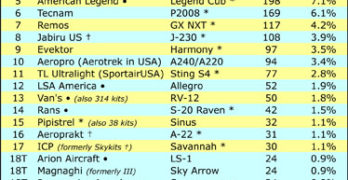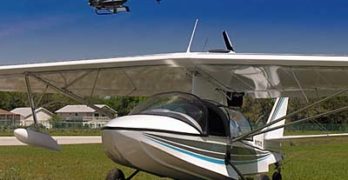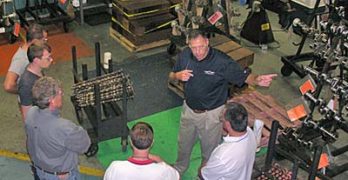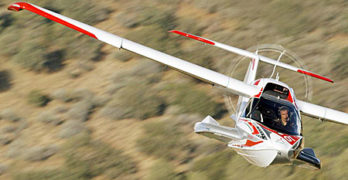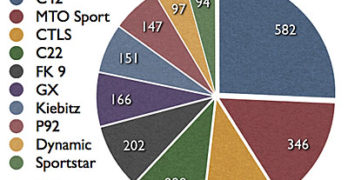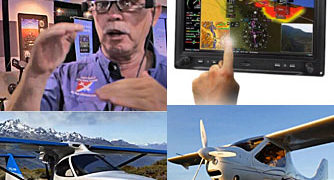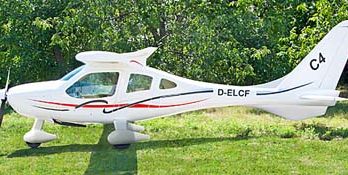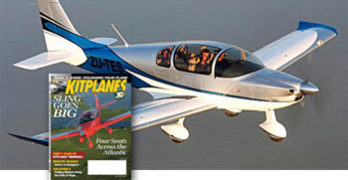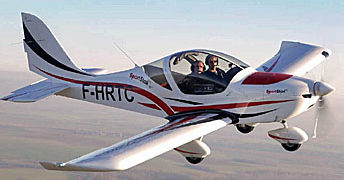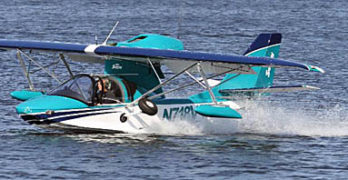As spring approaches and with major airshows like Aero Friedrichshafen in Germany and Sun ‘n Fun in Florida about to trigger a new season of recreational flying, it is time for an annual update of Light-Sport Aircraft market shares. Our well-known “fleet” chart appears nearby; this table refers to all Special LSA registered with FAA in the United States since the first aircraft was accepted by FAA almost ten years ago (on April 5, 2005).
We again post our Calendar 2014 tally that shows the success only in that year as a means of drawing attention to those brands and models performing the best in the last twelve months. We remind you that these charts use as their source the FAA registration (N-number) database, that is then carefully studied and corrected to make the most reliable report possible. However, two points: (1) this report will still have some errors as the database on which we rely has some faulty information … though we believe this to be modest and, as noted, we correct it where we can; and, (2) aircraft registrations are not likely to be perfectly in sync with company records of sales for a variety of reasons.
Search Results for : Flight Design
Not finding exactly what you expected? Try our advanced search option.
Select a manufacturer to go straight to all our content about that manufacturer.
Select an aircraft model to go straight to all our content about that model.
Fresh American LSA & Ultralight Exports
Wait! “…Exports?” I realize that might look like a typo. Did I intend to write LSA imports? Nope, exports is the correct word. Back in the early days of Light-Sport Aircraft, circa 2005-6-7, the source countries manufacturing the LSA people were buying were of a high percentage European with the Czech Republic leading the charge. Their penetration of the market was approximately two-thirds of all LSA. Then came the global economic recession, which happened as the industry began to mature. All were affected: domestic and international companies and pilot consumers. Some handsome imported aircraft never found a market.
In any downturn, some managers adapt quicker to the changing economy. They find a way to offer new aircraft to keep the momentum. Neither were American companies sitting on their thumbs. European builders had a head start because the European-style ultralights they had been manufacturing were close to what FAA allowed as LSA, so many models could be rapidly adapted to meet the Yankee marketplace.
Touring Aviation Stalwart Continental Motors
Continental Motors is known to generations of pilots and not just in the USA. However, I’ll bet most readers do not know that the storied company once produced a radial engine. The company started business way back in 1905 as a builder of truck engines for the U.S. Army. They entered the aviation market in 1929 with the seven cylinder A-70 powerplant. A year later Continental introduced A40 that went to four horizontally opposed cylinders in what is sometimes called a boxer engine. “We were the first to introduce the horizontally opposed cylinder configuration to help increase aircraft speeds,” observed the company. Rotax has generated well deserved publicity with their efficient fuel injected 912 iS but Continental noted that they were “the first to introduce both fuel injection and turbo-charging in general aviation aircraft (both in the 1960s).” They do not offer such configurations for Light-Sport Aircraft, at least not yet although in 2009 Continental threw support behind the new segment introducing the O-200 lighter weight engine that comes in at 199 pounds.
Icon Updates Their Order Book; Forecasts Delivery
One of the most-watched Light-Sport Aircraft is Icon’s A5 seaplane. Through savvy marketing and a splashy display and events at AirVenture (the only show where Icon Aircraft regularly exhibits), the company has clearly wowed potential buyers, the general aviation public, plus media journalists and photographers. ByDanJohnson.com has followed Icon since the beginning, actually even before the beginning, so we are pleased to continue our updates on their progress. Most observers see that it has been a long road. I first met CEO Kirk Hawkins back on the EAA Sport Pilot Tour in 2005 when he was — as he put it himself — “one guy with a business card.” Whatever you may think about the road long traveled, Kirk has taken his company from nowhere to one of the most closely tracked enterprises in the entire LSA space worldwide. His training for this lengthy exercise began at California’s respected Stanford University Graduate School of Business where he learned the Silicon Valley way to make a big impact … what the tech industry likes to call “creative destruction,” leaving behind the old ways of methodically introducing products and embracing the Internet style of taking bold leaps forward.
Germany’s Top 10 Ultralights by Aerokurier
Much of what we hear and know about airplane populations is centered on America. Yet in the world of sport and recreational aviation, the rest of the world equates to at least a 1:1 relationship, that is, for every American aircraft flying, many experts agree another flies internationally. It may be more significant than that … consider Germany.
In mid-August, our friends at Aerokurier, Germany’s leading aviation magazine, assembled an article about the top 10 ultralights in that country. A European ultralight, as you may know, is not the same as an American ultralight that is today limited to a single seat and no more than 254 pounds of empty weight. In Germany and elsewhere around the European Union, “ultralight” refers to an airplane much like a U.S. Light-Sport but limited in weight to 472.5 kilograms or 1,041 pounds.
Originally the weight limit had been 450 kilograms or 992 pounds but because emergency airframe parachutes are mandatory in Germany the weight was increased a few years ago to cover this component.
A Million Minutes (of Video) Every Month
Traffic to this website grew significantly in the last few years, starting a steep upward path in 2012 and in May this year hitting a peak of almost 75,000 Unique Visitors. First, a thank you for your regular visits! Then, a question: why is that so? It’s impossible to say why 60-70,000 people do something each month but a leading candidate reason has to be our embrace of video thanks to our partnerhip with Lightsport and Ultralight Flyer, publishing these days to YouTube under the name SportAviationMagazine.com. It seems clear … people love video! Comments we receive at airshows are now commonly related to video though we hear good things about our effort at covering all the news for Light-Sport Aircraft, light kit aircraft, and ultralights.
Recent Posts — (top left, clockwise) Sampling the AeroGlass heads-up display eyewear when visiting Levil Tech • Garmin‘s new G3X Touch • Flight Design CTLSi comparing Rotax 912ULS and 912iS plus new Dynon gear • New MVP from MVP.aero wowed the crowds at AirVenture 2014
My video partner and I create well over 100 new videos per year and I just uploaded eight new ones (images) with many, many more to follow.
Crumple Zones Coming to Light Aircraft
For more than 100 years, cars have had accidents and if they were severe enough, the results were poor (photo). This was long before seat belts, airbags, breakaway steering columns, padded dashboards, and many other features we take for granted today. It was also before the concept of crumple zones. Typically, crumple zones are located in the front part of the vehicle to absorb the impact of a head-on collision because 65% of crashes are frontal impacts, according to a British study. Crumple zones accomplish two safety goals: They reduce the initial force of the crash; and they redistribute the force before it reaches the vehicle’s occupants.This idea has been around more than 60 years and has become standard in the modern era of passenger car design. One of the first examples of crumple zone research is coming from Mercedes-Benz in the mid-1950s, so perhaps it is fitting that some of the first crumple zone technology to be applied to light aircraft has the sponsorship of the German government along with German industry players.
Is This the “New GA?” … LSA Four Seaters
Something of a stealth invasion is beginning. I refer to an emerging flock of four seat Light-Sport Aircraft. Of course, most readers are aware that no such birds exist as LSA (in the FAA’s code, anyway). By U.S. regulation Light-Sport are two seat aircraft. Other nations have some different ideas. For now, suffice it to say the “LSA 4s” — as I choose to call them for this article — are on final. In the past I’ve written about Evektor’s Cobra, one of the first in this group, arriving so early that you probably would not call it a “LSA-like” airplane. The southern Czech company enjoyed success with their SportStar and Harmony, smaller siblings to a four seater they flew several years ago. After Evektor (coincidentally also the very first LSA to be approved), we began to hear about Flight Design’s C4 modeled on their LSA market-leading CT series.
Evektor with Dynon Earns EASA Type Certificate
The very first aircraft ever to receive approval in the USA as a Light-Sport Aircraft is Evektor-Aerotechnik’s SportStar. No challenger can ever take away that title yet the company has continually developed this pioneeering airplane and recently achieved a new level of approval … one that alters the landscape in a way I predict we’ll see more as FAA’s Part 23 rewrite project progresses. “Following several months of certification process EASA has approved glass cockpit Dynon SkyView [as] SportStar RTC,” Evektor announced. RTC stands for Restricted Type Certificate. It is not identical the U.S. Part 23 Type Certificate — representing a somewhat lower level of government oversight — but a company earning this has to jump through many regulatory hoops. “SportStar RTC has become the first EASA certified aircraft approved with the SkyView glass cockpit [by proving] compliance with certification requirements of the EASA CS-LSA regulations. Dynon’s SkyView, recently upgraded to permit touch functionality, is widely known and used on Light-Sport Aircraft.
Searey Expands into China; Opens Sales Office
The list of aviation companies involved in one way or another with China is getting so long I won’t try to show them all here. Big companies like Cirrus Design or Continental are included. So are LSA manufacturers of various brands. Some business are setting up dealerships (Quicksilver, others). Others have arranged Chinese partners to build planes in-country (Flight Design, Zenith, others). Several companies have been fully acquired by or have received substantial funding from Chinese enterprises (Icon, others) and I’m aware of more that we will hear more about in the weeks and months to follow. The U.S. government and many other nations have borrowed from the Chinese government so a nearly unfathomable amount of dollars or other currencies are parked in China. However, most of the aviation financial arrangements are private, showing that, like their government, Chinese business people have plenty of funds to invest.
- « Previous Page
- 1
- …
- 19
- 20
- 21
- 22
- 23
- …
- 147
- Next Page »


